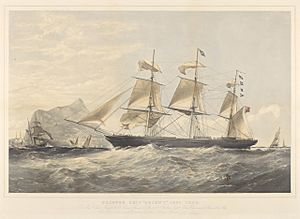Orient (clipper ship) facts for kids

Orient by Thomas Goldsworthy Dutton and William Foster, about 1860
|
|
Quick facts for kids History |
|
|---|---|
| Name | Orient |
| Owner |
|
| Port of registry | |
| Builder | Thomas Bilbe, Rotherhithe |
| Launched | 1853 |
| Completed | 14 December 1853 |
| Identification | |
| Fate | Scrapped 1925 |
| General characteristics | |
| Tonnage | 1,133 GRT, 1,032 NRT |
| Length | 184.4 ft (56.2 m) |
| Beam | 31.7 ft (9.7 m) |
| Depth | 21.1 ft (6.4 m) |
| Sail plan |
|
Orient was a famous sailing ship built in England in 1853. She had a wooden hull and three tall masts. Orient sailed the seas for many years. She first helped in a war and then carried people and goods between Great Britain and Australia. This amazing ship was finally taken apart in Gibraltar in 1925.
Contents
Building a Great Ship
The Orient was built by Thomas Bilbe at Nelson Dock in Rotherhithe, England. She was launched in 1853 and finished on December 14 of that year. She was a very long ship, measuring about 184.4 ft (56.2 m) (56 meters). Her width was 31.7 ft (9.7 m) (9.7 meters) and her depth was 21.1 ft (6.4 m) (6.4 meters).
Orient had a special type of hull called a composite hull. This meant she had a strong iron frame covered with timber planks. This design made her very sturdy. She also had comfortable cabin space for passengers, which was new for ships built by Bilbe.
The first owner of Orient was James Thomson & Co. They were also known as "The Orient Line." They registered the ship in London. Her official number in the United Kingdom was 12981. Her special code letters were VTHC, which helped identify her at sea.
Orient at Work: Her Career
Orient was built to sail to Australia, but her first job was different. The Crimean War started in October 1854. The UK Government quickly hired Orient as "Transport No. 78."
Serving in the Crimean War
She began as a troop ship. She carried important military supplies and soldiers from the 88th Regiment of Foot to Crimea. This was a very important role during the war.
Later, from October 1855, Orient became a hospital ship. She helped care for sick and injured soldiers. In 1856, after the war ended, the UK Government returned her to her owners.
Voyages to Australia
In 1856, Orient finally made her first trip to Australia. Under Captain A Lawrence, she carried people hoping to find gold in Australia's goldfields to Sydney.
From 1857 to 1877, Orient made regular trips from Portsmouth directly to Adelaide. These journeys were very important for connecting Great Britain with Australia. In 1861, James Thompson & Co started calling their shipping service "The Orient Line of Packets," or simply "Orient Line."
A Fire at Sea
In January 1862, Orient faced a big challenge. She was sailing from Cape Town to London when a fire broke out in the South Atlantic. The fire was so serious that the ship was almost destroyed.
Another Dutch ship came close by, ready to rescue everyone on board. Captain Lawrence and his crew could have left the ship. But they bravely stayed and fought the fire for a whole day. They managed to get the fire under control.
Orient was able to reach Ascension Island. Her damaged cargo was unloaded there, and she received temporary repairs. The insurance companies were so impressed by the captain and crew's bravery that they gave them a generous reward.
New Captains and Fast Journeys
Orient had several captains during her long career. Her second captain was Captain Harris. Under his command, she made some of her fastest trips from Plymouth to Port Adelaide. One notable journey in 1866 took only 72 days.
Later captains included Roland De Steiger (1868–1871), WH Mitchell (1873–1876), and Martin Haffner (1876–1878).
Later Years and Fate
In April 1879, a company called Cox Brothers bought Orient. They registered her in Waterford, Ireland. They used her for trade across the Atlantic Ocean.
In 1886, her rigging was changed. She was no longer a full-rigged ship but became a barque. This meant she had a slightly different sail setup.
In 1890, Smith, Imossi & Co bought her. They were agents for the P&O shipping company. They turned Orient into a coal hulk in Gibraltar. A hulk is an old ship that is no longer used for sailing. It is often used as a floating storage unit. Orient was used to store coal for other ships.
Finally, in 1925, after many years of service, Orient was taken apart and scrapped in Gibraltar.
Recognizing Orient
Orient was an important ship, and she has been recognized in several ways:
- Australia Post once released a 45-cent stamp that featured the Orient.
- In 1888, a famous artist named Charles Conder painted the ship. His painting is called Departure of the Orient – Circular Quay. He painted it just before he left Sydney.
- The National Maritime Museum has a painting of Orient by Thomas Goldsworthy Dutton.

